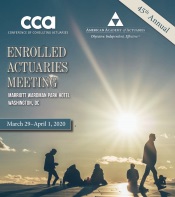The Retirement Report, Winter 2020
Vol 3 | No. 1
What the SECURE Act Means for Retirement Security

Levering Congress passed the bipartisan Setting Every Community Up for Retirement Enhancement (SECURE) Act in December, which President Trump signed into law on Dec. 20. (Read the Academy alert.) The new law includes a number of changes to employer-sponsored retirement plans and individual retirement accounts (IRAs), and features many provisions, including adding a safe harbor for selecting lifetime income providers in defined contribution plans, increasing access to retirement plans by making it easier for smaller employers to join open multiple employer plans (MEPs), and requiring part-time workers to be covered in existing employer plans.
The Academy asked Cindy Levering, who sits on both the Retirement System Assessment and Policy Committee and the Lifetime Income Risk Joint Committee, and is a past member of the Labor Department’s ERISA Advisory Council, some questions about the new law.
The SECURE Act is the most significant retirement legislation since the Pension Protection Act of 2006. What do you see as the most significant impacts of the new law?
The new law will strengthen the retirement system at a time when many Americans do not have access to an employer plan. It seeks to provide Americans with information to help them understand how much savings they need and how to make those savings last for their lifetime. If plan sponsors choose to add lifetime income options to their plans, participants will have access to income they won’t outlive. Small employers will get a tax credit to offset the costs of starting a 401(k) plan (or SIMPLE IRA) plan with auto-enrollment. Finally, while the “pooled employer plans” (PEP) provisions are intended to increase access to employer-sponsored plans as described below, how much they will actually do so is unknown.
Many workers do not have access to retirement plans sponsored by their employers during their entire working careers, putting their financial security in retirement in jeopardy. How does the SECURE Act address this scenario?
Two provisions of the new law address this. First, the requirement for plan sponsors to expand coverage to certain part-time employees will be beneficial to millions of Americans previously denied access to the opportunity to participate in employer plans. Second, SECURE enables the formation of PEPs, effective for plan years beginning after 2020. This new type of arrangement is a 401(k) plan that would allow multiple, unrelated employers to participate in the same plan without having the so-called “common nexus” that has historically been required for multiple employer plans. However, there is a question about how these PEPs will interact with the current state-based retirement plans that have already been established or where legislation has been passed or is pending.
With fewer workers having access to employer-sponsored defined benefit plans, defined contribution plans have become the primary vehicle for providing income in retirement. The SECURE Act requires illustrations of how much annual income an account balance will provide—how does that help participants?
Helping plan participants understand their retirement accounts in terms of lifetime income is a critical component in improving the decumulation challenge retirees face, and this illustration is an important step in that direction. But this may be more of an opportunity to educate employees about the challenge than to provide them with an actual numerical projection, because there are many factors that go into this calculation. The “devil is in the details” in terms of selection of pre-retirement assumptions such as future employee and employer contribution rates and investment performance as well as post-retirement assumptions such as retirement age, life expectancy, discount rates, and inflation. In addition, many participants have retirement savings outside the employer’s plan that would not be included in this illustration.
The required disclosure provides an opportunity to describe the differences between investment drawdown and annuity purchase approaches in securing lifetime income, including the pros and cons of each.
More employers might offer annuity options within their defined contribution plans as a result of the SECURE Act. Would this be beneficial for all employers to do, and what barriers still might prevent employers from doing this?
Very few plans currently offer annuity options or methods of periodic distribution due to concern about potential fiduciary liability related to the choice of an insurer. The SECURE Act has established a safe harbor for determining the financial capability of an insurer, which could result in more plan sponsors offering this option—although they will still have fiduciary responsibility for the choice of the actual product. This was one of the issues addressed by the ERISA Advisory Council in 2018, as detailed in this report.
The new law raises the age for Required Minimum Distributions (RMDs) to age 72. With increases in longevity, might this age be further increased?
Because this is the first time in over 40 years that this age has been increased, it is unlikely that it will be increased again in the near future. Note that individuals can now continue to contribute a traditional IRA past age 70½ as long as they are still working. Non-spouse beneficiaries must take inherited IRAs within 10 years, eliminating the so-called “stretch IRA.” In addition, the tables used to calculate RMDs are being updated effective Jan. 1, 2021.
What other legislative actions would be helpful to improve retirement security for Americans?
While the SECURE Act provides options for smaller employers to benefit from economies of scale by joining PEPs, it does not address the millions of Americans who lack access to saving for retirement through their workplace. This will be difficult to accomplish short of making such access mandatory. In addition, it is imperative that action be taken soon to strengthen and preserve Social Security and Medicare, which are critical programs for millions of Americans.
PPC Webinar Series to Look at Retirement Plan Coverage
 The Pension Practice Council (PPC) will kick off a three-part webinar series next month, “Retirement Plan Coverage in America: Today’s Realities and Tomorrow’s Prospects,” which will focus on the state of the current retirement system where just over half of American workers are participating in employer-sponsored plans. Plan coverage and financial status data will be presented, along with general background on how these plans are operated and funded and the governance structures under which they operate. Recent public policy proposals and actions also will be discussed.
The Pension Practice Council (PPC) will kick off a three-part webinar series next month, “Retirement Plan Coverage in America: Today’s Realities and Tomorrow’s Prospects,” which will focus on the state of the current retirement system where just over half of American workers are participating in employer-sponsored plans. Plan coverage and financial status data will be presented, along with general background on how these plans are operated and funded and the governance structures under which they operate. Recent public policy proposals and actions also will be discussed.
The webinars will be:
- “Focus on Multiemployer Plans,” on March 24, will feature Christian Benjaminson, chairperson of the Multiemployer Plans Committee, Joe Hicks, vice chairperson, and committee member Susan Boyle;
- “Focus on Public Pension Plans,” set for April 23; and
- “Focus on Private-Sector Plans, State Programs, and Opportunities to Expand Coverage,” date to be determined.
Multiemployer Plans Committee Comments on Pension Reform Plan
The Multiemployer Plans Committee sent a comment letter in December to the chairpersons of U.S. Senate Finance Committee and the Senate Committee on Health, Education, Labor, and Pensions in response to the “Multiemployer Pension Recapitalization and Reform Plan” released in November by them.
While noting the proposal would make sweeping changes to nearly all aspects of multiemployer plan funding, governance, and administration, the letter cites affected areas including Pension Benefit Guaranty Corporation (PBGC) guaranteed benefits and financial assistance, mergers, zone statuses, disclosures, and mass withdrawal. The comments cite concerns in areas including assumptions and discount rates, PBGC premiums, partitions, and withdrawal liability.
Updated Social Security and IRS Amounts for 2020
Click here to examine annually updated Social Security and IRS tables. The four tables herein list updated figures for IRS pension limits, Social Security amounts, covered compensation, and PBGC premiums for 2020.
Academy 2020 Election Guides Offer Insight on Key Retirement, Pension Issues
 With the 2020 presidential election cycle getting into full swing with the “Super Tuesday” coming up on March 3, the Academy has released 2020 Making Issues Count, which offers voters information on key retirement and pension issues including Social Security, secure retirements, and more.
With the 2020 presidential election cycle getting into full swing with the “Super Tuesday” coming up on March 3, the Academy has released 2020 Making Issues Count, which offers voters information on key retirement and pension issues including Social Security, secure retirements, and more.
The guides give pertinent background information and sample questions for presidential and congressional candidates about financial challenges and public policy reform options for major insurance and retirement systems and programs like Social Security, as well as Medicare, and retirement risk and other practice-area issues.
“Financial security issues are top-of-mind for millions of Americans in this important election year, and the Academy considers it paramount to provide nonpartisan information about the issues based on our profession’s unique expertise in analyzing risk to voters ahead of next month’s Iowa caucuses,” said Academy President D. Joeff Williams.
“Many voters have read or heard about proposals debated by candidates but want more information about the issues and the potential impacts of changes. The Academy’s election issues guide provides objective background information and informed discussion of different policy approaches on an array of particular financial risk issues, as well as suggesting questions that can help get to the heart of the candidates’ positions and proposals,” Williams said.
Pension Webinar Looks at Working With Auditors
The Academy’s Pension Committee hosted a Dec. 16 webinar, “Working With Auditors: Stories From Inside the Audit Engagement,” drawing upon the committee’s Working With Auditors of Pension and OPEB Plans practice note.

KleinstuberPanelists—individuals who routinely support audit engagements and actuaries serving as valuation actuaries for their clients—gave background on the standards that guide audit engagements and how those influence the work of auditors and actuaries when supporting an audit engagement. Presenters were John Stokesbury, vice chairperson for the Actuarial Board for Counseling and Discipline; Stephen Eisenstein; and Stephen Breeding, a member of the Pension Accounting Resource Group. Ellen Kleinstuber, a member of the Pension Risk Transfer Work Group, moderated.
Kleinstuber gave an introductory overview of the respective roles and vantage points of clients and their auditors, supplying the context actuaries need to understand and support the engagement most effectively. Because actuarial issues are often outside of the scope of the internal finance and audit personnel at a company and the accountants that work for the external auditing firm, both parties may involve an actuary to work for them as a specialist. U.S. Qualification Standards and the Code of Professional Conduct, along with actuarial standards of practice (ASOPs), guide such actuarial work, with a variety of ASOPs typically coming into play during audit engagements, the panelists said.
Eisenstein elaborated on how the use of specialists like actuaries is governed by the Public Company Accounting Oversight Board (PCAOB), a private-sector, nonprofit corporation created by the Sarbanes–Oxley Act of 2002. Actuaries working as specialists generally fall into one of two categories: Responding Actuaries, who work for the company in preparing pension or OPEB valuation results to be used in the financial statements, and Reviewing Actuaries, who assist the auditor with their review. Use of specialists is on the increase “in both frequency and significance,” he noted.
Stokesbury addressed a central question that shapes the work of auditors themselves, examining what exactly an audit is and how its characteristics drive the engagement. Qualifying an audit as “fact-based, well documented, and cognizant of both confirming and contradicting evidence,” he stressed how this understanding provides context for actuaries to better understand just what auditors are seeking from them. Breeding also addressed the theme by sharing insights on accounting terminology relating to evaluation of audit evidence.
Slides and audio are available for logged-in Academy members.
The Intersector Group released notes of its November meetings with the Treasury Department and the IRS, and the Pension Benefit Guaranty Corporation.
IRS Announces Renewal Season Open for Enrolled Actuaries
The IRS opened the renewal season for enrolled actuaries for the April 1, 2020 – March 31, 2023, period. The Joint Board for Enrollment of Actuaries (JBEA) has asked the Academy to help publicize the re-enrollment period. For details on the renewal form and instructions, click here.
Obituary: Senate Aide Chris Allen, Worked on Pension, Finance Issues
Chris Allen, tax and benefits counsel for the majority professional staff of the U.S. Senate Finance Committee, died in January. He was 58. Allen—who was a breakout-session speaker at the Academy’s Annual Meeting and Public Policy Forum last year—also served as legislative assistant for tax issues under Sen. Pat Roberts (R-Kan.) from 2011 to 2018, before moving to the Finance Committee, Roll Call reported.
“Chris was a public servant who brought a deep well of knowledge to his work, and he will leave behind a legacy of impact on so many lives that he was able to improve with his expertise, competence and hard work,” Sen. Chuck Grassley (R-Iowa) said in a statement. “Chris was a blessing to those who were fortunate enough to know him, and he will be greatly missed.”
Roberts said in a statement that Allen “had a brilliant mind, a generosity of spirit and a passion for serving the country in the United States Senate.”
EA Meeting Set for March 29 – April 1
 The 45th annual Enrolled Actuaries (EA) Meeting will be held March 29 – April 1 in Washington, D.C. Sponsored jointly by the Academy and the Conference of Consulting Actuaries, the EA Meeting will offer panels, workshops, and speakers covering a variety of topics and issues relevant to enrolled actuaries and other pension professionals.
The 45th annual Enrolled Actuaries (EA) Meeting will be held March 29 – April 1 in Washington, D.C. Sponsored jointly by the Academy and the Conference of Consulting Actuaries, the EA Meeting will offer panels, workshops, and speakers covering a variety of topics and issues relevant to enrolled actuaries and other pension professionals.
Highlights include:
- “Dialogue With and Update from the PBGC for Multiemployer Plans” will include Jason Russell, a member of the Academy’s Pension Committee and Immediate Past Chairperson of the Multiemployer Plans Committee, and the Pension Benefit Guaranty Corporation’s (PBGC) Ted Goldman, former Academy senior pension fellow.
- “ASB Standards for Pension Actuaries” will include Academy Board member Frank Todisco, a former member of the Actuarial Standards Board (ASB) and the ASB’s Pension Task Force.
- “Multiemployer Plans and Public Plans for Single-Employer Actuaries” will include David Driscoll, a member of the Actuarial Board for Counseling and Discipline.
- A “Multiemployer Plans Workshop,” featuring past Academy Pension Vice President Josh Shapiro.
The EA Meeting will also include a general session on ethics, which will include EA credit, subject to Joint Board for the Enrollment of Actuaries approval. The preliminary agenda is available online—register today for discounted registrations, which are still available.



